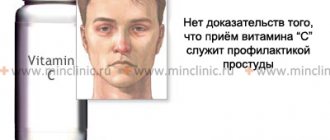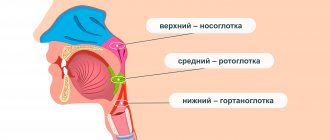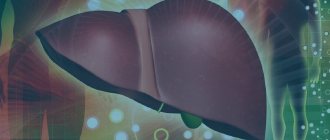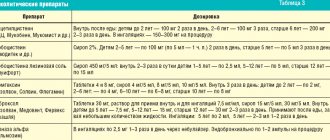Rhinitis, or, as it is more simply called, a runny nose, is an inflammation of the nasal mucosa, causing difficulty in breathing freely through the nose.
Author:
- Galkin Alexey Vladimirovich
ENT pathology expert
(Voted by: )
Rhinitis , or, as it is more simply called, a runny nose, is an inflammation of the nasal mucosa, which makes it difficult to breathe through the nose. The infectious process is characterized by copious mucous discharge from the nose, congestion, sneezing, a feeling of squeezing in the bridge of the nose, loss of smell, and headache. This is a common disease: it accounts for up to a third of all ENT diseases in childhood. Even a newborn can get rhinitis; the disease has no age restrictions.
With frequent episodes of recurrence of rhinitis, the child’s general, including psychological, health suffers, his performance at school decreases, and complications may arise (otitis media, sinusitis, bronchitis, etc.). It is important to prevent the disease from exacerbating and becoming chronic, so at the very beginning of the development of a runny nose, you should consult a pediatrician. There are several types of rhinitis. When making a diagnosis and prescribing treatment, one must proceed from the specifics of its course and the causes of its occurrence. Only a doctor can prescribe effective therapy that will quickly relieve the child of the disease, will not cause adverse reactions and will prevent frequent relapses.
Manifestations of acute rhinitis in newborns and infants
Acute rhinitis is especially unpleasant in the first months of life - in infants, the nasal passages are still very narrow, they do not know how to blow their nose on their own, because of this, it is difficult or impossible for the child to breathe through the nose, even with slight swelling of the mucous membrane. As a result, the process of feeding and sleep is disrupted. The child breathes frequently and shallowly through his mouth, is restless, his temperature rises, dacryocystitis (inflammation of the lacrimal sac) may develop, and weight loss may begin. Continuous breathing through the mouth, resulting from the inability to breathe through the nose, can cause loose stools and vomiting.
Symptoms of acute rhinitis in older children
In older children, acute runny nose develops quickly. At first, a feeling of unpleasant burning, tickling, and itching in the nasal cavity is noticeable. Then frequent mucous discharge begins, sneezing, congestion, headaches, tearfulness, decreased perception of smells, a feeling of squeezing in the bridge of the nose, irritation on the skin under the nose.
Acute rhinitis has a rapid phase of progression - a decrease in general symptoms, stabilization of the condition occurs after about a week. However, this does not mean that during this period you should wait for independent recovery and not contact a pediatrician. Undertreated or ineffectively treated acute rhinitis can become chronic or cause complications.
Symptoms of chronic rhinitis
- Catarrhal. Its symptoms are similar to acute rhinitis, but it occurs with less pronounced symptoms. It is characterized by constant mucus secretions, alternating sinus congestion, and frequent coughing.
- Vasomotor. It has specific symptoms: a runny nose appears in paroxysms, with periodic relief, sneezing, watery eyes, and headaches. During an attack of a runny nose, increased sweating, redness of the face, nervous tension, fever, and a feeling of numbness or tingling of the skin are noted.
- Hypertrophic. It manifests itself as difficulty breathing freely through the nose, pain in the head and sinuses, decreased sense of smell and hearing, changes in voice, high fatigue, which leads to problems with school performance.
- Atrophic. This is not the most common form in children. It manifests itself in the form of ozena (“fetid runny nose”) - discharge in the form of viscous mucus, dry nose, the appearance of crusts with an unpleasant odor, nosebleeds, difficulty in nasal breathing.
- Allergic. It occurs in response to the presence of an allergen and is accompanied by systematic repeated sneezing (in the form of attacks), liquid discharge, itching in the nasal cavity, decreased sense of smell, congestion, worsening at night.
What is it like?
Depending on the causes and characteristics of the course, a child may have a runny nose1,2:
Spicy
- Infectious : viral, bacterial, fungal or mixed. Among the viruses, the most common causes of the disease are adenoviruses, rhinoviruses, influenza and parainfluenza viruses - in total there are more than 90 different pathogens1.
Of the bacteria, the most common are pneumococci, streptococci, staphylococci - those that usually live in the respiratory tract of healthy people and show aggression when immunity decreases.
- Allergic – occurs as a manifestation of intolerance of the body, for example, during the flowering season of certain plants.
- Traumatic – developing after inhalation of dust and smoke, with thermal burns, ingestion of foreign bodies and substances, after surgical interventions.
Important! The cause of obstructed air passage through the respiratory tract may be a foreign body1,4. A baby can insert it so deeply that nothing will be visible upon external examination. Therefore, a runny nose without fever in a child under three years of age is a reason for mandatory consultation with a doctor.
Chronic
It can also be:
- infectious;
- allergic, year-round, for example, in the case of allergies to house dust, and seasonal, in case of allergies to pollen;
- vasomotor – arising as a result of an inadequate response to signals from the nervous system, often against the background of problems with the thyroid gland1.
More often, chronic rhinitis is accompanied by proliferation ( hypertrophy ) of the nasal turbinates, which requires surgical treatment1,4. The atrophic variant, in which thinning of the mucosa is observed, is extremely rare in children and occurs mainly against the background of dependence on vasoconstrictor drugs1,2,4.
Why does rhinitis develop in children?
The nasal mucosa is the most important barrier preventing the penetration of pathogenic bacteria into the respiratory tract. In a healthy state, mucus envelops pathogens and removes them from the nose. But under negative conditions, for example, hypothermia, decreased immunity, increased concentration of harmful substances in the air, the protective function of the mucous membrane suffers and an inflammatory process can begin.
The following factors also contribute to a decrease in the protective function of the mucous membrane:
- deviated nasal septum;
- Immunity disorder or immune system disease;
- diathesis;
- adenoids and polyps;
- foreign body entering the nose and sinuses;
- long-term use of vasoconstrictor drugs.
Rhinitis can be either an independent disease or one of the symptoms of infections (influenza, whooping cough, measles, scarlet fever, meningococcus, diphtheria, etc.). Therefore, a medical approach to its diagnosis is needed.
How to alleviate the condition of a child’s body with a runny nose?
A severe runny nose and nasal congestion in a child not only interferes with the baby’s breathing, but also with eating, speaking, and sleeping. Adults can alleviate the child’s condition using simple methods:
- Maintaining optimal temperature and humidity levels in the room. The temperature should vary from 18 to 22 degrees, but lower is better than higher. Humidity, on the contrary, should be relatively high: 50-70%. You can increase its level by regularly carrying out wet cleaning or using air humidification methods - spraying, artificial humidifiers.
Proper nose blowing is important. “Sniffing” your nose provokes infection to enter deeper into the nasopharynx. You should not blow your nose through both nostrils at the same time - this can cause otitis media. Each nostril is blown separately, while the other is covered.- Experts advise using disposable paper handkerchiefs, since bacteria easily multiply in the damp environment of a fabric handkerchief.
- For young children, secretions are removed using an aspirator. This procedure must be carried out very carefully so as not to damage the delicate mucous membrane of the nasal passages.
- Rinsing the nose with saline solutions. To do this, you will need a solution with sea salt, for example, Sialor Aqua. The healing properties of sea water are based on its affinity with the intercellular fluid in the human body. Microelements and salts found in sea water have an anti-inflammatory and antiseptic effect, improve metabolic processes in tissues and help restore the protective properties of the mucous membrane. Saline irrigation of the nose is recommended as a preventive measure for colds. To avoid frequent colds, it is enough to rinse your nose with sea water several times a week.
- Elimination of swelling of the mucous membrane. To do this, it is necessary to select an effective vasoconstrictor drug. One of the best is Sialor Reno. Its main active ingredient, oxymetazoline, will quickly relieve nasal congestion and ease the child’s breathing.
- Allergic runny nose. The therapeutic regimen is selected individually and exclusively by the doctor. Self-medication can lead to tragic consequences! First, the specialist will determine the source of the allergy, then prescribe antihistamines. The task of parents is to exclude the child from contact with allergens and regularly carry out wet cleaning of the room.
All of the above methods are designed to soften the course of the disease and eliminate some unpleasant symptoms. Now let’s look at what you shouldn’t do when a child has a runny nose, and what methods are recommended by modern medicine.
Methods for diagnosing rhinitis in children
A pediatric otolaryngologist diagnoses and treats rhinitis in children. The diagnosis is made based on complaints from the child and parents, medical history, data from a nasal smear, rhinoscopy results, and blood tests to determine the state of immunity. Pharyngoscopy, endoscopic biopsy, radiography of the paranasal sinuses, and histological examination of a mucosal biopsy may be needed. For symptoms of allergic rhinitis, children are examined by an allergist-immunologist.
Room microclimate
The state of the air in the room significantly affects the functioning of the mucous membrane of the upper respiratory tract. Dry, warm air is irritating, while cool, humid air is soothing. Optimal conditions:
- temperature 18-20°C,
- humidity 60-70%,
- regular ventilation,
- wet cleaning.
Air humidifiers, purifiers, ionizers and other devices can help with this. To alleviate the condition and local hydration of the mucous membranes, you can use inhalations with saline solution.
Children suffering from allergic rhinitis are especially sensitive to environmental factors.
Treatment methods for rhinitis in children
Treatment of rhinitis in children is always complex and may include:
- Impact directly on the pathogen - the appointment of antibacterial and antiviral agents.
- Antiallergic therapy - used if rhinitis is of an allergic nature or in case of infectious-allergic inflammation.
- Treatment of symptoms: antipyretic, anti-inflammatory, antitussive drugs, inhalations, vasoconstrictor sprays or drops. Local vasoconstrictor drugs should not be used for more than a week, otherwise they are addictive and contribute to the development of drug-induced rhinitis. Vasoconstrictor drugs temporarily improve nasal breathing, but do not cure the disease itself. If the child does not yet know how to use nasal sprays himself, the doctor will teach the parents how to use them correctly.
- Physiotherapy: UHF, ultraphonophoresis, magnetic therapy, paraffin treatment, ultraviolet irradiation (quartz tube), laser treatment, endonasal electrophoresis.
- Surgical procedures: resection of a deviated septum, removal of adenoids, polyps, cryodestruction of the mucous membrane, etc.
- Homeopathic remedies.
- Massage of bioactive points of the head.
Typically, treatment of rhinitis in children is carried out on an outpatient basis. Hospitalization is carried out:
- at high temperature;
- with hemorrhagic syndrome;
- at the onset of complications;
- with severe respiratory failure;
- in case of illness in a newborn.
To walk or not?
Tiunova Elena
K.M.N., pediatrician of the highest category, nutritionist
“A runny nose is not a hindrance to walking if there is no increase in temperature and the baby’s general well-being does not suffer, and the weather conditions allow it.”
The main thing is to follow the following rules. And remember that the goal is not games and physical activity, but breathing fresh air.
1. Nasal breathing should be free.
2. Avoid contact with other children and adults.
3. Use masks in enclosed spaces (elevators, entrances).
Sleeping in the fresh air is encouraged.








